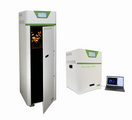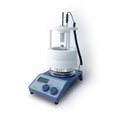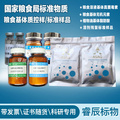FL3500双调制叶绿素荧光仪部分参考文献
(新升级型号为FL6000)
1.Manaa A.,et al. (2019)Salinity tolerance of quinoa (Chenopodium quinoaWilld) as assessed by chloroplast ultrastructure and photosynthetic performance. Environmental and Experimental Botany, Volume 162, Pages 103-114
2.Sicora C. I., et al. (2019)Regulation of PSII function in Cyanothece sp. ATCC 51142 during a light–dark cycle. Photosynthesis Research, Volume 139, Issue 1–3, pp 461–473
3.Smythers A. L.,et al. (2019)Characterizing the effect of Poast on Chlorella vulgaris, a non-target organism. Chemosphere, Volume 219, Pages 704-712
4.Albanese P.,et al. (2018) Thylakoid proteome modulation in pea plants grown at different irradiances: quantitative proteomic profiling in a non‐model organism aided by transcriptomic data integration. The Plant Journal, Volume96, Issue4, Pages 786-800
5.Antal T., KonyukhovI., Volgusheva A., et al. (2018) Chlorophyll fluorescence induction and relaxation system for the continuous monitoring of photosynthetic capacity in photobioreactors. PhysiolPlantarum. DOI: 10.1111/ppl.12693
6.Antal T. K., Maslakov A., Yakovleva O. V., et al. (2018). Simulation of chlorophyll fluorescence rise and decay kinetics, and P700-related absorbance changes by using a rule-based kinetic Monte-Carlo method. Photosynthesis Research. DOI:10.1007/s11120-018-0564-2
7.Biswas S., Eaton-Rye J. J. (2018). PsbY is required for prevention of photodamage to photosystem II in a PsbM-lacking mutant of Synechocystis sp. PCC 6803. Photosynthetica, 56(1), 200–209.
8.Bonisteel E. M.,et al. (2018).Strain specific differences in rates of Photosystem II repair in picocyanobacteria correlate to differences in FtsH protein levels and isoform expression patterns. PLoS ONE 13(12): e0209115.
9.Fang X., et al. (2018).Transcriptomic responses of the marine cyanobacteriumProchlorococcus to viral lysis products. Environmental Microbiology, doi: 10.1101/394122.
10.Hanelt D. (2018). Photosynthesis assessed by chlorophyll fluorescence. Bioassays, Elsevier, Pages 169-198.
12.Liefer J. D.,Garg A. Campbell D. A., et al. (2018) Nitrogen starvation induces distinct photosynthetic responses and recovery dynamics in diatoms and prasinophytes. PLoS ONE. DOI: 10.1371/journal.pone.0195705
13.Malerba M. E., Palacios M. M., Palacios Delgado Y. M.,et al. (2018) Cell size, photosynthesis and the package effect: an artificial selection approach. New Phytologist. DOI: 10.1111/nph.15163
14.Patel V. K.,et al. (2018)Characterization of Seven Species of Cyanobacteria for High-Quality Biomass Production. Arabian Journal for Science and Engineering, Volume 43, Issue 1, pp 109–121
15.Pavlou A., Jacques J., Ahmadova N., Mamedov F., &Styring S.(2018). The wavelength of the incident light determines the primary charge separation pathway in Photosystem II. Scientific Reports, 8(1). DOI:10.1038/s41598-018-21101-w
16.Perkins R., Williamson C., Lavaud J.,et al. (2018) Time-dependent upregulation of electron transport with concomitant induction of regulated excitation dissipation in Hasleadiatoms. Photosynth Res. DOI: 10.1007/s11120-018-0508-x
17.Poulin C., D. Antoine, and Y. Huot. (2018). Diurnal variations of the optical properties of phytoplankton in a laboratory experiment and their implication for using inherent optical properties to measure biomass," Opt. Express 26, 711-729.
18.Semin B. K., Davletshina L. N., &Mamedov M. D. (2017). Effect of different methods of Ca2 extraction from PSII oxygen-evolving complex on the QA− oxidation kinetics. Photosynthesis Research, 136(1), 83–91.
19.Spijkerman E., Behrend H., Fach B., &Gaedke U. (2018). Decreased phosphorus incorporation explains the negative effect of high iron concentrations in the green microalga Chlamydomonasacidophila. Science of The Total Environment, 626, 1342–1349.
20.Solhaug K. A., Chowdhury D. P., &Gauslaa Y. (2018). Short- and long-term freezing effects in a coastal (Lobariavirens) versus a widespread lichen (L. pulmonaria). Cryobiology, 82, 124–129.
21.Takagi D., Ifuku K., Nishimura T. and Miyake C. (2018) Antimycin A inhibits cytohrome b559-mediated cyclic electron flow within photosystem II. Photosynth Res. DOI: 10.1007/s11120-018-0519-7
22.Ungerer J., Lin P-C., Chen H-Y., Pakrasi H. B. (2018) Adjustments to photosystem stoichiometry and electron transfer proteins are key to the remarkably fast growth of the cyanobacteriumSynechococcuselongatusUTEX 2973. mBio 9:e02327-17.
23.Xu K., Lavaud J., Perkins R., Austen E., Bonnanfant M., & Campbell D. A. (2018). Phytoplankton σPSII and Excitation Dissipation; Implications for Estimates of Primary Productivity. Frontiers in Marine Science, 5. DOI:10.3389/fmars.2018.00281
24.Yu Z., et al. (2018)Physiological changes in Chlamydomonasreinhardtii after 1000 generations of selection of cadmium exposure at environmentally relevant concentrations. Environmental Science: Processes & Impacts, DOI:10.1039/C8EM00106E
25.Yu Z., et al. (2018)Effects of TiO2, SiO2, Ag and CdTe/CdS quantum dots nanoparticles on toxicity of cadmium towards Chlamydomonasreinhardtii. Ecotoxicology and Environmental Safety, Volume 156, Pages 75-86
26.Yussi M. Palacios, AvigadVonshak, and John Beardall (2018) Photosynthetic and growth responses of Nannochloropsisoculata(Eustigmatophyceae) during batch cultures in relation to light intensity. Phycologia: 2018, Vol. 57, No. 5, pp. 492-502.
27.Ahmadova N., Ho F., Styring S. and Mamedov F. (2017) Tyrozine D oxidation and redox equilibrium in Photosystem II. BBA – Bioenergetics. DOI:10.1016/j.bbabio.2017.02.011
28.Albanese P.,et al. (2017)Pea PSII-LHCII supercomplexes form pairs by making connections across the stromal gap. Scientific Reports, 7: 10067, DOI:10.1038/s41598-017-10700-8
29.Belgio E., Trsková E., Kotabová E., et al. (2017) High light acclimation of Chromeraveliapoints to photoprotective NPQ. Photosynth Res. DOI: 10.1007/s11120-017-0385-8
30.Bernát G., Steinbach G., Kaňa R. et al. (2017). On the origin of the slow M–T chlorophyll A fluorescence decline in cyanobacteria: interplay of short-term light-responses. Photosynth Res. DOI: 10.1007/s11120-017-0458-8
31.Chiş C., Carmel D., Chiş I.et al. (2017) Expression of psbA1 gene in Synechocystis sp. PCC 6803 is influenced by CO2. Open Life Sci. DOI: 10.1515/biol-2017-0018
32.Felcmanová K., Lukeš M., Kotabová E., et al. (2017) Carbon use efficiencies and allocation strategies in Prochlorococcusmarinus strain PCC 9511 during nitrogenlimited growth. Photosynth Res. Volume 134. DOI: 10.1007/s11120-017-0418-3
33.Huokko T., et al. (2017)Role of type 2 NAD (P) H dehydrogenase NdbC in redox regulation of carbon allocation in Synechocystis. Plant Physiology, Vol. 174, pp. 1863–1880
34.Kamalanathan M, Thi Dao L. H., Chaisutyakorna P., et al. (2017) Photosynthetic physiology of Scenedesmus sp. (Chlorophyceae) under photoautotrophic and molasses-based heterotrophic and mixotrophic conditions. Phycologia. 56. No. 6. DOI: 10.2216/17-45.1
35.Li G. and Campbell D. A.(2017) Interactive effects of nitrogen and light on growth rates and RUBISCO content of small and large centric diatoms. Photosynth Res. Volume 131, DOI:10.1007/s11120-016-0301-7
36.Li G., Talmy D. and Campbell D. A. (2017) Diatom growth responses to photoperiod and light are predictable from dielreductant generation. J. Phycol. Volume 53. DOI: 10.1111/jpy.12483
37.Markou G., Dao L. H. T., Muylaert K. and Beardall J.(2017) Influence of different degrees of N limitation on photosystem II performance and heterogeneity of Chlorella vulgaris.Algal Research. Pages 84 – 92. DOI: 10.1016/j.algal.2017.07.005
38.Miyachi M., Ikehira S., Nishior D.,et al. (2017) Photocurrent generation of reconstituted photosystem II on self-assembled gold film. Langmuir.,Volume 33 (6). DOI: 10.1021/acs.langmuir.6b03499
39.Murphy C. D.,et al. (2017)Photoinactivation of Photosystem II in Prochlorococcus and Synechococcus. PLoS ONE, 12(1): e0168991
40.Nath A., et al. (2017)Microalgal consortia differentially modulate progressive adsorption of hexavalent chromium. Physiology and Molecular Biology of Plants, Volume 23, Issue 2, pp 269–280
41.Ni G., et al. (2017)Arctic Micromonas uses protein pools and non-photochemical quenching to cope with temperature restrictions on Photosystem II protein turnover. Photosynthesis Research, Volume 131, Issue 2, pp 203–220
42.Piwosz K., Kaftan D., Dean J., et al. (2017) Nonlinear effect of irradiance on photoheterotrophic activity and growth of the aerobic anoxygenic phototrophic bacterium Dinoroseobactershibae. Environmental microbiology. DOI: 10.1111/1462-2920.14003
43.Xu K., Grant-Burt J. L., Donaher N. and Campbell D. A. (2017) Connectivity among Photosystem II centers in Phytoplankters: Patterns and Responses. BBA – Bioenergetics. DOI:10.1016/j.bbabio.2017.03.003
44.Zhang X., Ma F., Zhu X.,et al. (2017) The acceptor side of photosystem II is the initial target of nitrite stress in Synechocystis sp. strain PCC 6803. Appl Environ Microbiol
45.Dao L. H. T. and Beardall J. (2016) Effects of lead on two green microalgae Chlorella and Scenedesmus: photosystem II activity and heterogenity. Algal Research. Volume 16. DOI: 10.1016/j.algal.2016.03.006.
46.Ferroni L., Suorsa M., Aro, E. M., et al. (2016) Light acclimation in the lycophyteSelaginellamartensii depends on changes in the amount of photosystems and on the flexibility of the light-harvesting complex II antenna association with both photosystems. New Phytol. Volume 211. DOI: 10.1111/nph.13939
47.Garcia-Chaves M. C., Cottrell M. T., Kirchman D. L. et al. (2016) Single-cell activity of freshwater aerobic anoxygenic phototrophic bacteria and their contribution to biomass production. The ISME Journal. Volume 10. DOI:10.1038/ismej.2015.242
48.Grama B. S., Agathos S. N. and Jeffryes C. S. (2016) Balancing Photosynthesis and Respiration Increases Microalgal Biomass Productivity during Photoheterotrophy on Glycerol. ACSSustainable Chem. Eng. Volume 4. Pages 1611–1618.
49.Kobayashi K., Endo K. and Wada H. (2016) Multiple Impacts of Loss of PlastidicPhosphatidylglycerol Biosynthesis on Photosynthesisduring Seedling Growth of Arabidopsis. Frontiers of Plant Sciences. Volume 7. DOI: 10.3389/fpls.2016.00336
50.Li G., Woroch A. D., Donaher N. A., Cockshutt A. M.,et al. (2016) A Hard Day's Night: Diatoms Continue Recycling Photosystem II in the Dark . Frontiers in Marine Science. Volume 3. DOI: 10.3389/fmars.2016.00218
51.Murphy C. D., Ni G., Li G., et al. (2016) Quantitating active photosystem II reaction center content from fluorescence induction transients. Limnol. Oceanogr. Methods. DOI:10.1002/lom3.10142
52.Patel V. K., Mají D., Pandey S. S., et al. 2016) Rapid budding EMS mutants of Synechocystis PCC 6803 producing carbohydrate or lipid enriched biomass, Algal Research. Volume 16. DOI: 10.1016/j.algal.2016.02.029.
53.Rehman A. U., Szabó M., Deák Z., et al. (2016) Symbiodinium sp. cells produce light-induced intra- and extracellular singlet oxygen, which mediates photodamage of the photosynthetic apparatus and has the potential to interact with the animal host in coral symbiosis. New Phytol. Volume 212. DOI:10.1111/nph.14056
54.Treves H., Raanan H., Kedem I., et al. (2016) The mechanisms whereby the green alga Chlorella ohadii isolated from desert soil crust, exhibits unparalleled photodamageresistence. New Phytologist. 210.DOI : 10.1111/nph.13870
55.Volgusheva A., Kruse O., Styring S., et al. (2016) Changes in the Photosystem II complex associated with hydrogen formation in sulfur deprived Chlamydomonasreinhardtii. Algal Research. Volume 18. DOI: 10.1016/j.algal.2016.06.025.
56.Wang J., Liu Q., Feng J., et al.(2016) Photosynthesis Inhibition of Pyrogallol Against the Bloom-Forming CyanobacteriumMicrocystisaeruginosa TY001. Pol. J. Environ. Stud. Volume 25. DOI: 10.15244/pjoes/63412
57.Cheregi O., Kotabová E., Prášil O., et al.(2015) Presence of state transitions in the cryptophyte alga Guillardia theta. Journal of Experimental Botany. Volume%





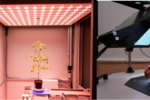
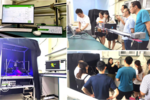
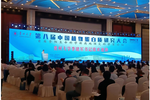
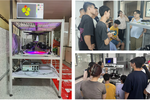


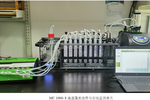






![聚酰胺粉 [柱层析用,高分离性能] 60-100目/80-120目/100-200目](https://p-06.caigou.com.cn/135x120/2024/7/2024071513085253637.jpg)

